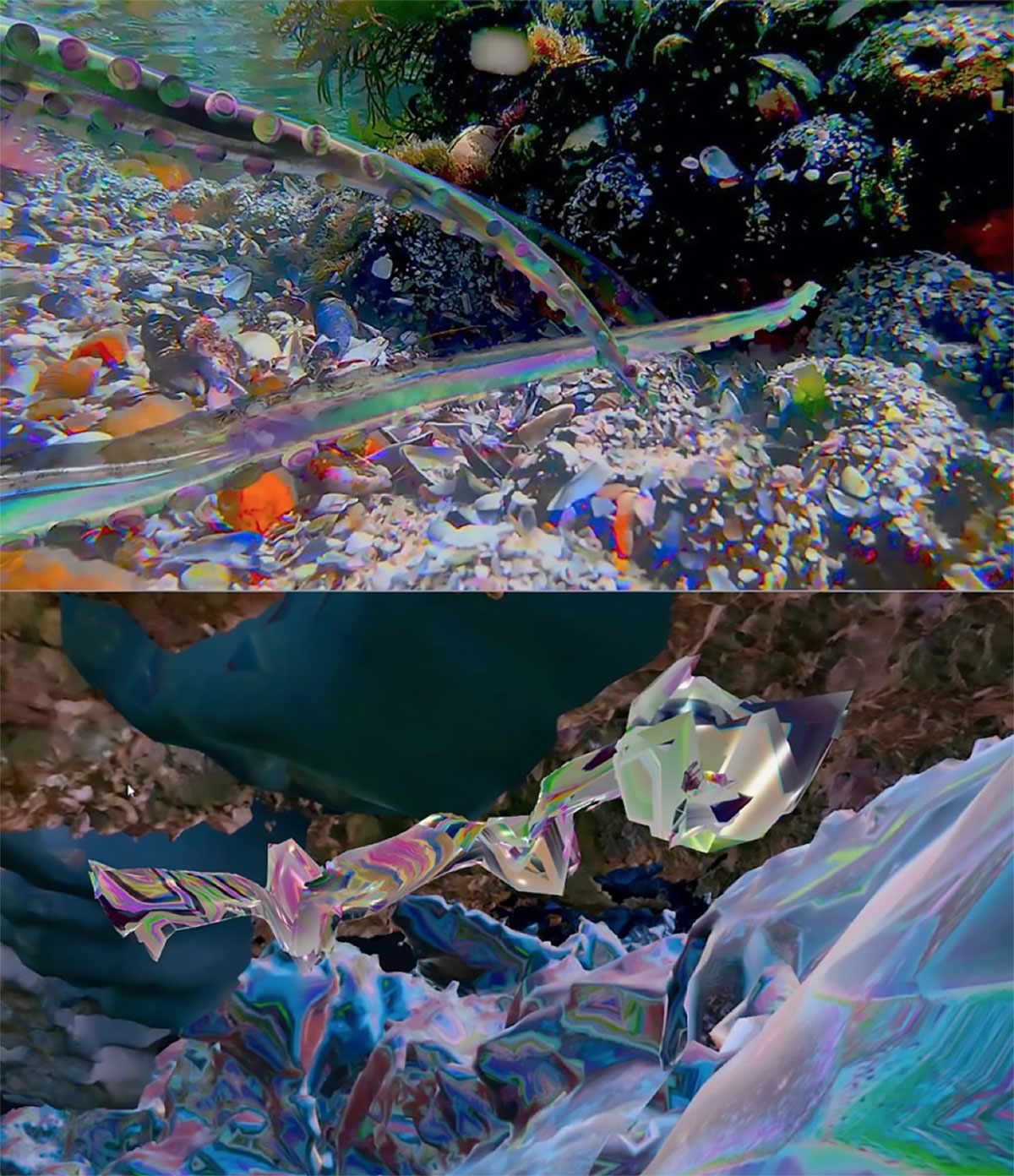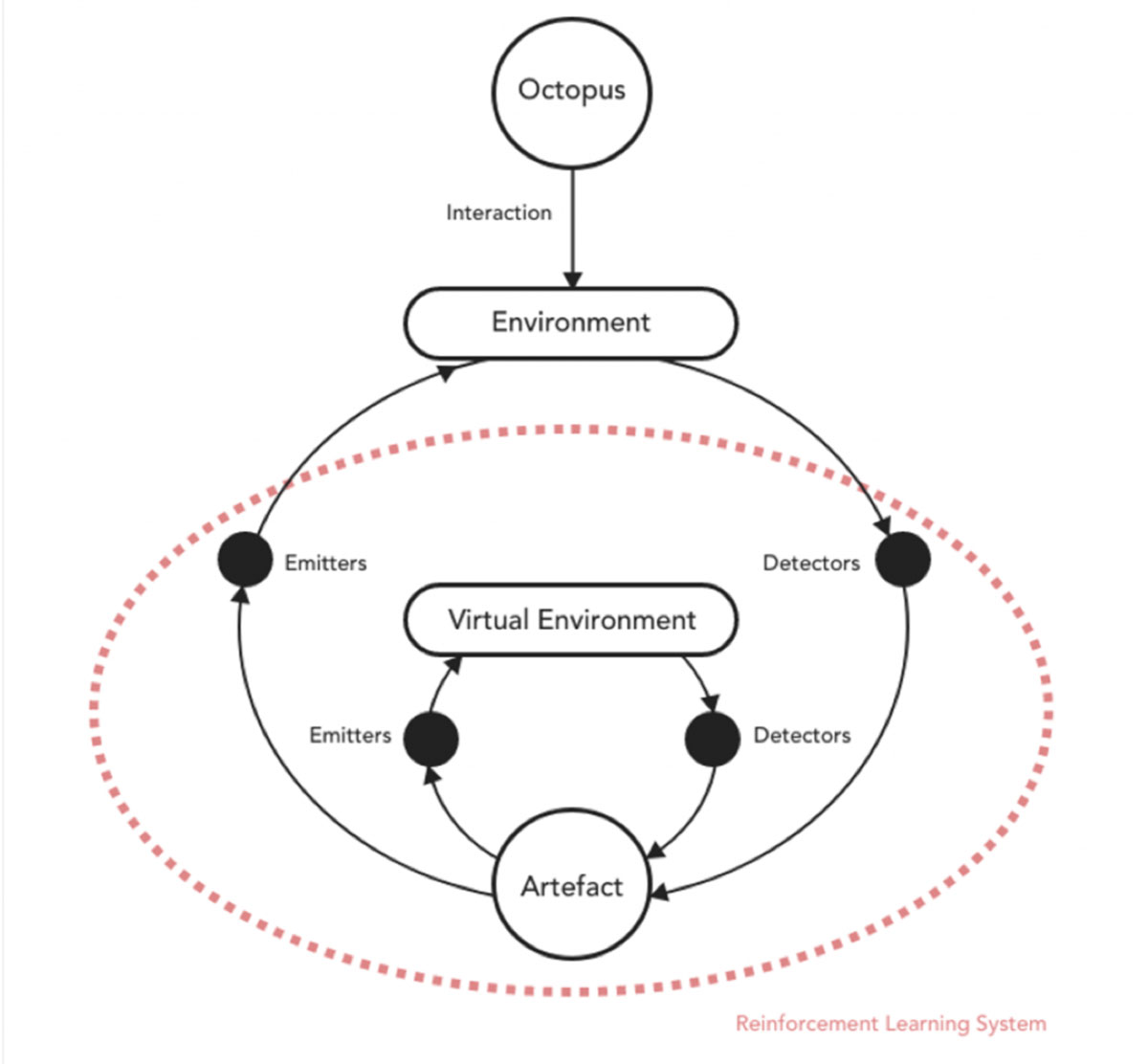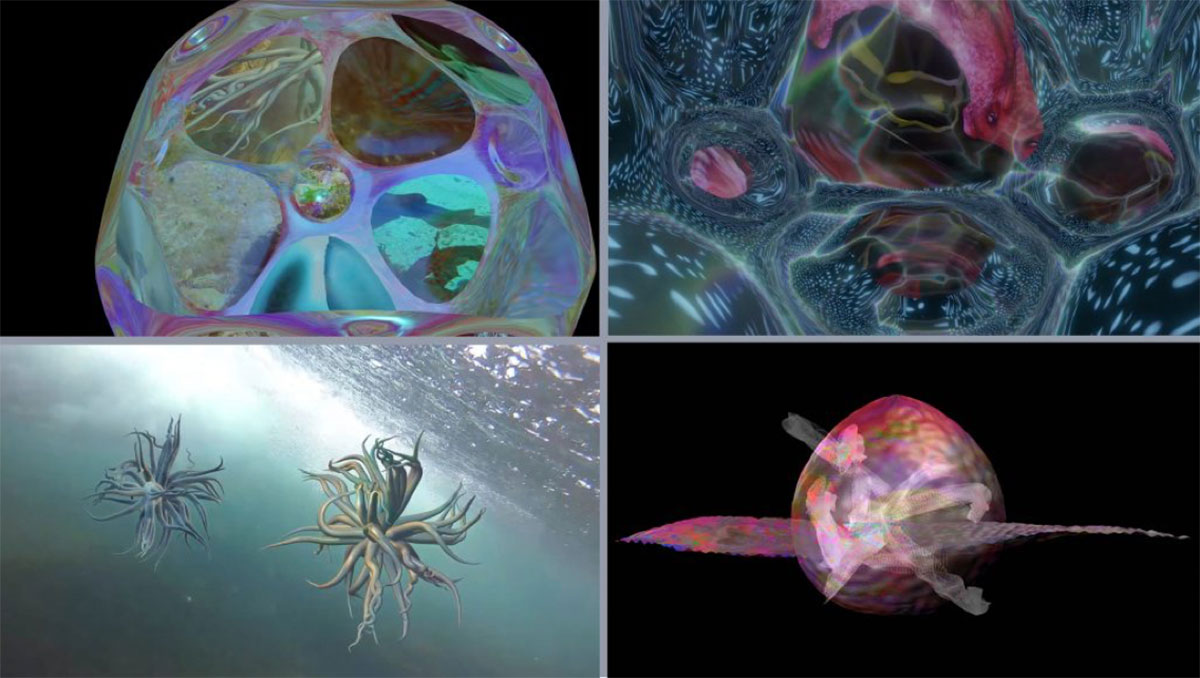How can an octopus, in an encounter with artificial intelligence, transform our understanding of technological development?
By Alasdair Milne
Fragmented patterning and colouration warp and pixelate along a CGI tentacle: imagery produced using Blender by a specialist team of VFX and visual coding artists portrays the ‘chemotactile’ senses of an octopus. The visuals on display here are, however, only part of an expansive art-and-technology research project. Further, these visuals are not ultimately intended for a human audience. ISCRI, or Interspecies Communication Research Initiative, is demo-ing prototypes that will provide the initial attempts to engage the interest of an octopus interlocutor. Over the course of 2020–21, the artistic and technical team behind ISCRI has produced artwork for an octopus, whom they hope will in return help them create a deviant form of artificial intelligence (AI), by coordinating a new type of multisensory encounter.
ISCRI is part of an emerging scene of artists who experiment with machine learning, a now-ubiquitous AI technology. These typically multidisciplinary teams of practitioners create through experimentation, centring processes, iteration and outcomes that aren’t predetermined. They aim to produce new knowledge by relinquishing the control conventionally associated with both art and computation. Working with indeterminacy opens up a space for potential knowledge formation, both in the shape of optics and data. Most interestingly, teams like ISCRI often build new systems, gathering data and putting it to work in the investigative realm of aesthetics, a field that has been transformed by the pattern-recognition capabilities of these new tools. For ISCRI, the reimagining of how data can be gathered and used gives rise to new modes of communication – and new ways of envisioning our relationship with nonhuman beings.
The Creative AI Lab at Serpentine, a partner on the project, was founded in 2020 to consolidate a research space for working through emergent concerns in AI aesthetics raised by projects like ISCRI, bringing together knowledge from different fields, and different institutional approaches to research. Ultimately this means a research agenda that crosses between the university context of King’s College London’s Department of Digital Humanities, and the Arts Technologies team situated at Serpentine Galleries.
My role working across both of these institutions as a PhD researcher at the Lab began a year ago, and sits specifically between the development of tactics for revealing the institutional and technological ‘back-end’ of the AI artworks we see in galleries (and increasingly elsewhere) and how artworks can be used to open up new understandings of machine-learning’s workings. Part of this is to connect with artists to understand how experimental approaches can aid a broader understanding of machine learning and how its societal usage could develop differently, as well as providing a space for conceptual incubation in order to better understand the infrastructure that needs to be created to support these complex projects both in the research and development (R&D) phase and in dissemination.
It was in this spirit of exchange that the ISCRI team first met with us at the Creative AI Lab. ISCRI is a project at the beginning of a long journey, but its origins date back to the mid-1990s. The work is driven by Maggie Roberts and Ranu Mukherjee, who first formed their collective practice 0rphan Drift (0D) in 1994. They have been engaged with questions of machinic intelligence for over twenty years, a timeline that tracks the societal transformations of an increasingly pervasive cyberspace. Roberts’ focus on the octopus – ‘a very curious animal’ – comes from a long-term engagement with the species through 0D’s work, previously culminating in the exhibition If AI were Cephalopod (2019) at Telematic Gallery, San Francisco, and the Becoming Octopus Meditations (2020) commissioned by IMT Gallery, London.
Their research emerges against a backdrop of renewed interest in the intellectual lives and possibilities of nonhuman (or to use posthumanist Karen Barard’s term, more-than-human) entities: animals and machines, and specifically the octopus. This animal in particular, with a nervous system located throughout its body rather than centralised in the brain, raises questions concerning where intelligence is located – in the brain, throughout the body, even within an intelligent agent’s environment – and what we can even understand intelligence to be. At the same time, the use of machine learning (the now predominant form of AI) in animal communication is becoming more widespread, for example in attempts to decode the sonic exchanges of whales. So far, however, these capabilities have been employed primarily as a way of interpreting, rather than facilitating, a conversation with nonhumans.
This fascination with facilitating a conversation between nonhuman entities, like an octopus and AI, where human legibility is not an ultimate goal, has led directly to ISCRI. Given the complexity of the project, a collective working group with various expertise is necessary. In this case, 0D sought the help of technologists at Etic Lab, and various marine biology and animal communication experts (Stazione Zoologica Anton Dohrn, Naples, and Aberystwyth University).
Etic Lab is a Wales-based digital research and design partnership that looks for new ways to engage machine learning. Often working outside of the arts space, the practice is driven by an acute understanding of the tech sector: elsewhere its projects range from using AI to democratise access to affordable legal advice, to engineering new approaches to data privacy for external organisations. 0D and Etic come together to form a collaboration of already collaborative teams. Each unit brings its own capabilities and expertise. They take what Stephanie Moran, Associate Partner at Etic has called a ‘whole-systems approach’ to the production of this octopus-AI encounter, influenced by the cybernetic theories of Gregory Bateson, whose understanding of data, and ‘ecology’ in its broadest sense, underpin Etic’s thinking.
The fundamental purpose of this octopus ↔ AI encounter is to bring an octopus into reciprocal communication with a machine-learning system, via its environment, and on its own terms. ISCRI will invite the octopus to engage with a range of intriguing stimuli, hoping as facilitators to ‘triangulate a conversation’ between octopus and machinic intelligences, as Moran (Etic) puts it.
The encounter will take place in a mesocosm, an artificial re-creation of the octopus’ marine habitat, at Aberystwyth University. This phase of the project will be facilitated and overseen by marine biologists with expertise in the care of octopuses.[1] A video stream, created for the octopus by 0D, will be gently presented as a curiosity to the octopus, to be engaged with as – or if – it wishes. For Mukherjee (0D), the mesocosm is a place where the natural and the cultural come together: ‘The mesocosm is like an exhibition, and a habitat for the octopus […] we have to make this environment, and so […] those objects are, in a sense, cultural objects.’ Discussing the artworks that 0D will provide as gestures to the octopus, Mukherjee adds: ‘We’re inviting this creature to interact with them, to understand if there’s some sort of response, which is exactly what an artwork does for humans.’ For this purpose, ISCRI enlisted computational artists Megan Bagshaw, Duncan Paterson and George Simms, working to produce an extensive corpus of fluid visual materials in the hope of gaining the octopus’ interest. Visual-ecological research informs what is offered to the octopus: Mukherjee points out that ‘One of the other reasons why we’re thinking about pattern so much is that it is a language, like all pattern is a form of language […] you can see structure, but not understand it. I think it’s very different from total chaos.’ The search for patterns is a practice common to both artists and technologists, and within ISCRI the range of methods employed are as intriguing for their differences as they are for their similarities.

Polarised Light Vision. The Becoming Octopus Meditations and ISCRI animation stills, 0rphan Drift 2020–21. Maggie Roberts, artist. Megan Bagshaw, VFX supervision. Thanks to Etic Lab for Cephalopod behaviour research and Anna Breytenbach for Interspecies communication.
Etic has been developing a new way to technologically realise this theoretical approach: it plans to use a specific form of machine learning – unsupervised, reinforcement learning – not to translate octopus communications, but to try and learn something about what octopus communication is. For Etic Lab partner Alex Hogan, the system differs from conventional machine learning in its aim ‘to make something else [something non-human, like the octopus] the supervisor’, and for that ‘“something else” to define what system equilibrium would look like’. Rather than offering training in advance on a pre-prepared dataset, reinforcement learning is used to find higher-dimensional patterns in the octopus’ response that humans might not be able to detect. Relinquishing control to the octopus put the machine-learning system more directly into conversation with the octopus, turning the humans who designed the system into observers.
‘Machine learning looks for patterns’, explains Moran. ‘So it’s about pattern recognition. But most of what people think of as machine learning is where it’s been trained on something specific, like pictures of cats or dogs [with the goal of better identifying cats or dogs in the future]. So it’s trying to learn something that you’ve told it to learn. But with reinforcement learning, it’s not trained on something, it looks at what’s there and finds patterns in it.’ It is building its own logic out of the sensory data it collects, as a set of statistics that the encounter will output.

Fig 1 courtesy of 0rphan Drift and Etic Lab 2021: ‘The emitters in Fig 1 consist of the video streaming installation; the detectors include audiovisual recording, and temperature, light level, full colour spectrum, water pressure and chemical sensors.’
Unlike conventional scientific experiments where the focus would be specifically on a single variable, such as how the octopus might respond to a specific sensory input like light, ISCRI’s interdisciplinary approach proposes that since the octopus’ distinctive intellect is so radically different from our own, the only viable approach is to bring all the senses together. Moran goes on: ‘The holistic data from all of the different senses will be pooled into the machine learning algorithm, and it will find the patterns in it, rather than us telling it [what] to look for.’This unsupervised approach affords the machine-learning system greater agency to detect patterns across and between multiple kinds of sensory inputs, necessary because, as Hogan points out, we have to accept that ‘we [humans in general] are so badly equipped to understand what communication is that we wouldn’t see it’, in part because the ML system will need to find patterns across ‘the rate of change of the rate of change’ in the data they record. In this respect, the system is intended to establish not just how to communicate with the octopus, but what that communication is in the first instance. As such, it might hopefully be better able to communicate with the octopus than we are – though we may not fully understand that communication.
The goal is to eventually work with this AI system, having been trained by the octopus, to produce artwork for an exhibition intended for humans. This exhibition, as Roberts puts it, ‘through the AI’s modulating presence that will control a multisensory environment, will offer audiences some insight into what an AI trained by a nonhuman intelligence’ might be able to elicit – in this way producing a ‘second mesocosm’ for humans to experience. This nonhuman machine-learning model is intended to offer a counterpoint to the AI developed in market-driven contexts where the primary metric is often an uncritical conception of ‘optimisation’.

Distributed Consciousness. The Becoming Octopus Meditations stills, 0rphan Drift, 2020. MaggieRoberts, artist. Megan Bagshaw, VFX supervision. Duncan Paterson, Visual coding. Thanks to Etic Lab for Cephalopod behaviour research and Anna Breytenbach for Interspecies communication.
In 1995, as 0D was starting out with its collective practice, theorist Kodwo Eshun wrote that through its work it aimed to ‘elaborate how digital technology is disassembling the human security system of the body’. ISCRI marks a culmination of that work, a moment in which 0D’s boundaries become porous. Collaboration is a transformative process for those involved, and throughout the R&D phase of this project the traditional roles of the artist and technician themselves become of interest as critical discussion and feedback across expertise provoke aesthetic and technical revisions to the broader system.
Perhaps all art-making is really encounter-making, but ISCRI’s blueprint opens up new possibilities for bringing together beings whose worlds have until now been considered too incompatible. Duncan Paterson of 0D notes that ‘the octopus is at one with its environment in ways we can’t imagine’. The blurring of individual and environment is one of the key lessons we can learn from ISCRI, because perhaps it’s as true for humans as it is for cephalopods. The consequences of this are profound – the difference between communication and behavioural observation collapses once you take away the distinction between an individual and its environment. It’s in the process of finding new ways to mediate that such realisations become possible.
Endnotes
[1] Marine Biologists have very stringent ethics around working with octopuses, under the 2010 EU Directive (Directive 2010/63/EU) that includes live cephalopods. Aberystwyth University holds a licence giving it ethical approval to keep octopuses under the terms of this directive. (This paper gives an overview: https://scielosp.org/pdf/aiss/2015.v51n4/267-269/en). A mesocosm is defined as an ‘ocean-like environment’, although interpretations of this vary. Graziano Fiorito at the Stazione Zoological Napoli, a key thinker for this project, has written extensively on mesocosms and octopus ethics.
Alasdair Milne is a PhD researcher with Serpentine’s Creative AI Lab and the Department of Digital Humanities at King’s College London. His work focuses on the collaborations and systems that emerge around new technologies.

